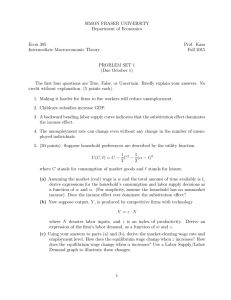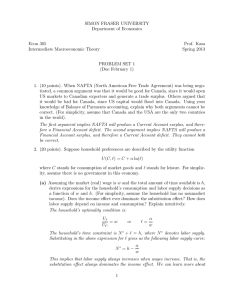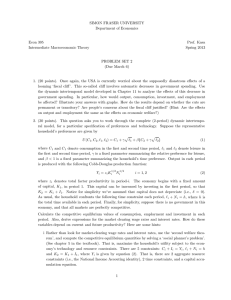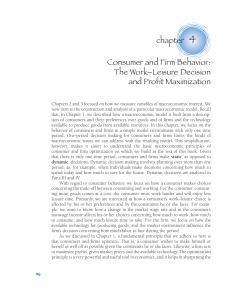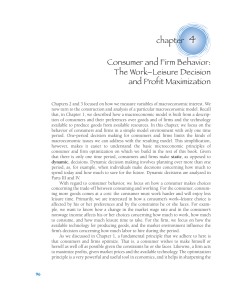SIMON FRASER UNIVERSITY Department of Economics Econ 305 Prof. Kasa
advertisement
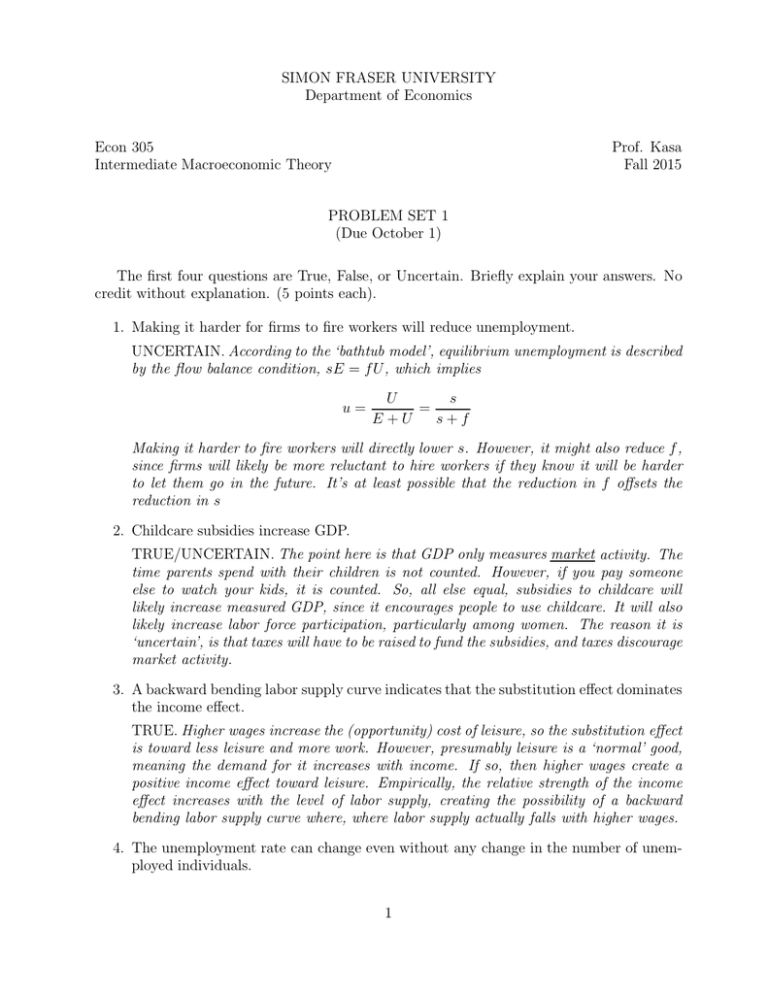
SIMON FRASER UNIVERSITY Department of Economics Econ 305 Intermediate Macroeconomic Theory Prof. Kasa Fall 2015 PROBLEM SET 1 (Due October 1) The first four questions are True, False, or Uncertain. Briefly explain your answers. No credit without explanation. (5 points each). 1. Making it harder for firms to fire workers will reduce unemployment. UNCERTAIN. According to the ‘bathtub model’, equilibrium unemployment is described by the flow balance condition, sE = fU , which implies u= U s = E+U s+f Making it harder to fire workers will directly lower s. However, it might also reduce f , since firms will likely be more reluctant to hire workers if they know it will be harder to let them go in the future. It’s at least possible that the reduction in f offsets the reduction in s 2. Childcare subsidies increase GDP. TRUE/UNCERTAIN. The point here is that GDP only measures market activity. The time parents spend with their children is not counted. However, if you pay someone else to watch your kids, it is counted. So, all else equal, subsidies to childcare will likely increase measured GDP, since it encourages people to use childcare. It will also likely increase labor force participation, particularly among women. The reason it is ‘uncertain’, is that taxes will have to be raised to fund the subsidies, and taxes discourage market activity. 3. A backward bending labor supply curve indicates that the substitution effect dominates the income effect. TRUE. Higher wages increase the (opportunity) cost of leisure, so the substitution effect is toward less leisure and more work. However, presumably leisure is a ‘normal’ good, meaning the demand for it increases with income. If so, then higher wages create a positive income effect toward leisure. Empirically, the relative strength of the income effect increases with the level of labor supply, creating the possibility of a backward bending labor supply curve where, where labor supply actually falls with higher wages. 4. The unemployment rate can change even without any change in the number of unemployed individuals. 1 TRUE. By definition, the unemployment rate is the raio of the number of unemployed people to the total labor force, which is the sum of the employed people and the unemployed people, U u= E+U So u can change without any change in U if there is a change in E. For example, if someone loses or quits their job, and does not look for a new one (ie., leaves the labor force), then this will reduce E and increase u. 5. (30 points). Suppose household preferences are described by the utility function 1 1 U (C, `) = C − C 2 − (α − `)2 2 2 where C stands for consumption of market goods and ` stands for leisure. (a) Assuming the market (real) wage is w and the total amount of time available is 1, derive expressions for the household’s consumption and labor supply decisions as a function of w and α. (For simplicity, assume the household has no nonmarket income). Does the income effect ever dominate the substitution effect? The household’s optimality condition is α−` U` =w = Uc 1−C Solving for C we get w+`−α w If we use this to sub out for C in the budget constraint, C + w` = w, we get C= `= w2 + α − w 1 + w2 Finally, since labor supply, N s = 1 − `, we find Ns = 1 − ` = 1−α+w 1 + w2 Note that N s < 0 if w < α − 1, so for a sensible equilibrium to√exist, we must have w > α − 1. Also note that N s is increasing in w until w = α, and then begins to decrease. At that point, the income effect begins to dominate the substitution effect, and we get a backward-bending labor supply curve. (Note that this assumes √ α > α − 1). Eventually, as wages continue to rise, N s converges to zero. (b) Now suppose output, Y , is produced by competitive firms with technology Y =z·N where N denotes labor inputs, and z is an index of productivity. Derive an expression of the firm’s labor demand, as a function of w and z. 2 The firm’s optimality condition is to set the marginal product of labor equal to the wage rate. Here the marginal product of labor is constant, and equal to z. As a result the labor demand curve is discontinuous - it is equal to zero for all w > z, it is a flat line (i.e., indeterminate) for w = z, and then jumps to infinity for w < z (since, each worker yields a profit, why not hire an infinite number of them!) (c) Using your answers to parts (a) and (b), derive the market-clearing wage rate and employment level. How does the equilibrium wage change when z increases? How does the equilibrium wage change when α increases? Use a Labor Supply/Labor Demand graph to illustrate these changes. The answer to part (b) implies that the market-clearing wage must be w = z (assuming z > α − 1, otherwise, households would not want to supply any labor). So to determine the equilibrium employment level, we just need to replace w with z in the household’s labor supply curve. This gives Ne = 1−α+z 1 + z2 If z increases, then wages rise one-for-one, and employment either rises or falls, depending on whether you are on the rising or falling portion of the labor supply curve. An increase in α shifts the labor supply curve to the left. This reduces equilibrium employment, but has no effect on wages (since the marginal product of labor is constant). 3
